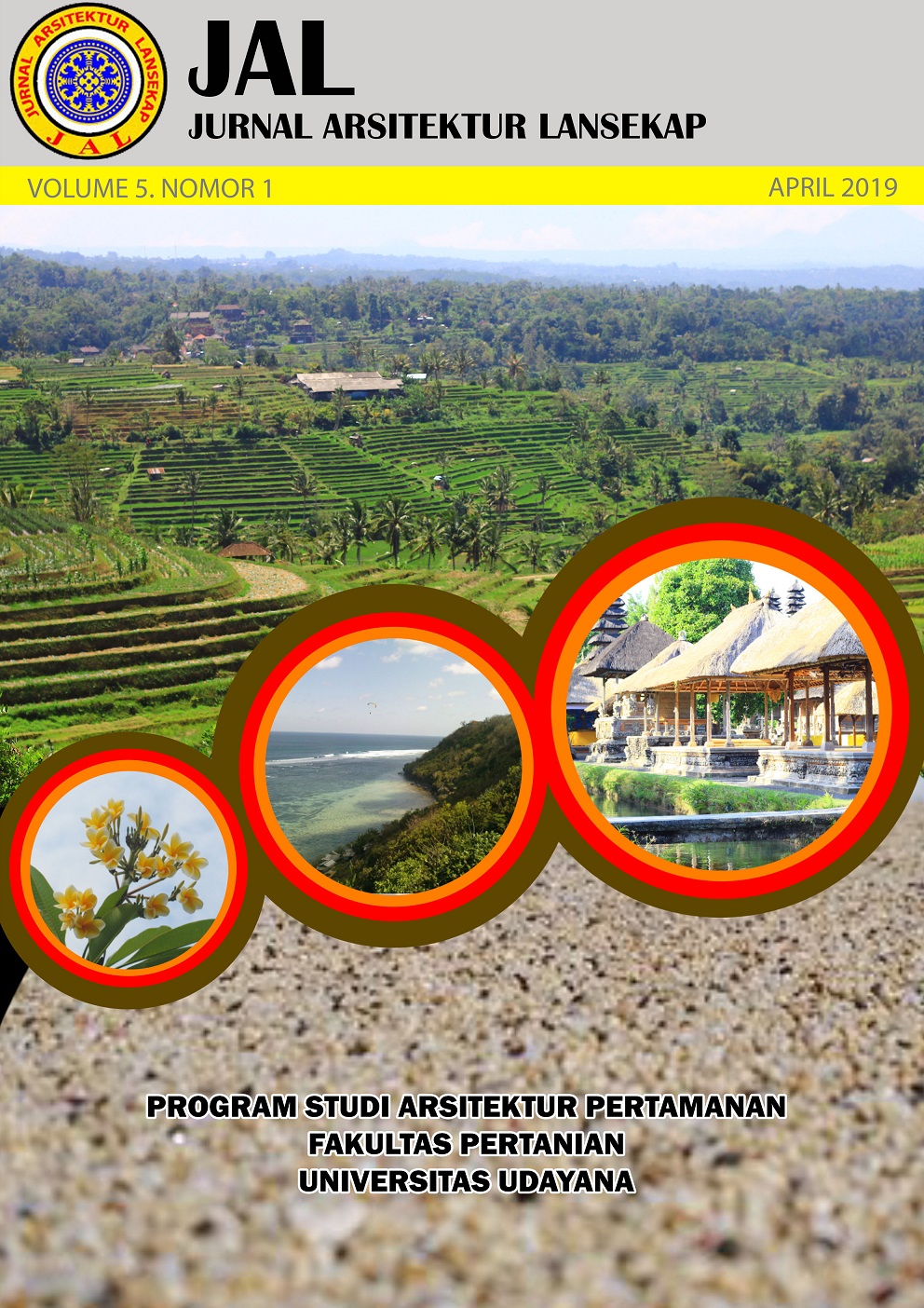Identifikasi dan pemetaan taman setra di Kota Denpasar berbasis teknologi Sistem Informasi Geografi (SIG)
Abstract
Identification and mapping of grave yard park in Denpasar City based on GIS technology. Bali as a garden island consists of several types of parks, one of which is Setra Park. In Bali there are 1,488 indigenous villages/pakraman. Each traditional village has at least one grave, and some have two to three graves. Thus in Bali it is estimated that there are more than 1500 graves, but until now there is no exact data on the number and extent of the graves in Bali, as well as those in the City of Denpasar. This study aims to identification and find out at once mapped Setra Park in the city of Denpasar, Bali as the first step to compile the data base of Taman Setra in Bali Province as one of the national assets of Unitary State of Republic of Indonesia which has architectural, functional, aesthetic, and socio-religious-magical. This study used the survey method with data retrieval technique with observation, interview, and questionnaire distribution to get primary data directly obtained in the field, as well as literature study to complete data or information not obtained in the field. As for mapping using GPS instruments (Global Positioning System) and QGIS software (Quantum Geography Information System). The collected data was followed by tabulation and then analyzed with Quickbird satellite image analysis in 2012 and QGIS 2010 to compile data base and at the same time making map of Taman Setra in Denpasar City. The result of this study shows that, all the parks in Denpasar have spatial layout based on mandala concept, namely: (1) Main mandala as head (ulu setra) in the form of Pura Prajapati building; (2) Madia mandala is a body (ragan setra) as a burial place corpse, arson, and pengabenan ceremony; (3) Nista mandala as foot (cokor/sor setra) area which functioned as garbage dump or rest of upakara. The total area varies from 0.07 to 8.90 Ha, with the land ownership status belonging to the respective village of pakraman, but only about 16.7% have been certified. The arrangement of the park is quite good and has multiple functions, as well as burial places, ceremonies, and other religious rituals also function as a park, a place to harvest rare plants, and at the same time have ecological functions as green open spaces are shady, comfortable, and interesting.
Downloads
References
Jawatan Agama Hindu dan Buddha Propinsi Bali. 1973. Tata Nuntun Miwah Midabdabin Desa Adat Ring Bali. Proyek Penyuluhan Agama Propinsi Bali. Denpasar.
Pemerintah Daerah Provinsi Bali. 2001. Peraturan Daerah Provinsi Bali Nomor 3 Tahun 2001. Pemerintah Daerah Provinsi Bali. Denpasar.
Pendit S., Nyoman. 1996. Hindu Dharma Abad XII Kesejahtraaan Global bagi Umat Manusia. Yayasan Dharma Narada. Denpasar.
Soekmono R. 1973. Pengantar Sejarah Kebudayaan Indonesia 2. Penerbit Kanisius. Yogyakarta.
Suada, I Nyoman. 2014. Bali dalam Persepektif Sejarah dan Tradisi dalam Relevansinya dengan Era Globalisasi menuju keajegan Bali yang Harmonis. Yayasan Surya Dewata Bali. Denpasar.
Suja, I Wayan. 2010. Kearifan Lokal Sains Asli Bali. Universitas Pendidikan Ganesha. Penerbit Paramita, Surabaya.
Widana, Ida Bagus Gede. 2011. Dharmaning Hasta Kosali Arsitektur tradisional Bali. Penerbit Dharma Putra. Denpasar.

This work is licensed under a Creative Commons Attribution 4.0 International License.
An author who publishes in the Jurnal Arsitektur Lansekap (JAL) agrees to the following terms:
- Author retains the copyright and grants the journal the right of first publication of the work simultaneously licensed under the Creative Commons Attribution-ShareAlike 4.0 License that allows others to share the work with an acknowledgement of the work's authorship and initial publication in this journal
- Author is able to enter into separate, additional contractual arrangements for the non-exclusive distribution of the journal's published version of the work (e.g., post it to an institutional repository or publish it in a book) with the acknowledgement of its initial publication in this journal.
- Author is permitted and encouraged to post his/her work online (e.g., in institutional repositories or on their website) prior to and during the submission process, as it can lead to productive exchanges, as well as earlier and greater citation of the published work (See The Effect of Open Access).
Read more about the Creative Commons Attribution-ShareAlike 4.0 Licence here: https://creativecommons.org/licenses/by-sa/4.0/.







